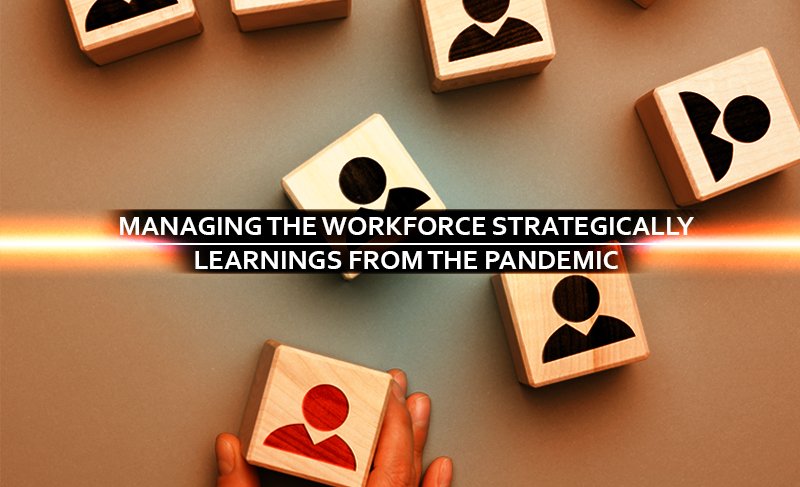
Managing The Workforce Strategically: Learnings From The Pandemic
“Workforce management is not only about assigning the tasks to employees and managing their roles and responsibilities but also about aligning the employees with a stress-free mindset and building emotional resilience in such testing times.”
The world has changed a lot since the COVID-19 pandemic has emerged. The ways of doing business have evolved, how industries manage their work and operations have undergone disruption, and how the communities at large communicate with each other saw a massive transition.
Call it the challenges of the pandemic or the opportunities that came with the challenges; the world is not the same anymore.
Organizations have undergone a massive shift in the businesses and operations at large, with changes in their BCPs (Business continuity plans), with the new business strategies at the forefront of managing the entire organization’s workforce.
A recently conducted research suggests a considerable shift in the workforce management with organizations focussing more on managing the employees strategically, both in terms of professional front and personal space.
People in the pandemic era are stressed, panicked, and in vulnerable situations.
Hence, it becomes imperative for organizations to tackle employees’ mental and emotional well-being in alignment with their goals and objectives.
While a stress-free mindset is necessary for achieving the firm’s vision, building emotional resilience among employees is significant.
Emotional resilience refers to one’s ability to cope with stressful events.
It is only possible when one is in the right mind frame and visualizes the event as a mere thought and not an immense tragedy; enabling one to see things differently.
Just like digital transformation resulted in organizations investing massively in digital tools and technologies; similarly, stressful situations such as a pandemic have led employers to believe in taking care of employees emotionally.
Emotional Resilience and Employees – Managing Workforce Strategically
According to recent research, since the pandemic has emerged; 23% of the organizations have believed in conducting activities apart from the routine work to enable employees to be at ease and diverting their mindsets towards fun activities; negating the panic situations, and stressed events.
Employees are the backbone of any organization. In the COVID-19 era; the organizations have reported declined efficiency, and this decline in effectiveness is directly proportional to employees’ well-being.
The below-discussed elements focus on maintaining emotional resilience among employees by carrying out specific functions in connection with employees’ well-being.
Flexibility and Adaptability:
With the rise in business practices that often comprises challenges; remaining flexible and adaptable to specific situations remains the topmost priority of an organization.
Training and development focusing on emotional; resilience, handling the setbacks, and stress management are some of the standard practices organizations are conducting to drive emotional stability and achieve growth.
Purpose:
A purpose-driven community performs better as compared to a purposeless community.
Organizations ensure business practices are employee-friendly, enabling people to achieve greater heights.
No matter how big the problem is, once the employees get a different perspective on a particular issue; their point of view toward the actual challenges tends to change. Therefore, purpose-driven growth is attained.
Connection:
The proper connection leads to the right set of people driving the growth and prosperity of an organization.
Timely training and development programs, seminars, and sessions filled with elements to dictate emotional resilience among the employees develop a connection between the employees and employers.
This further enables a robust working environment in the organization.
Hope:
Inculcating the element of hope triumphs everything.
Organizations’ main objective during the pandemic and post-pandemic times is imbibing the ray of hope among the employees.
There is nothing denying that challenges are plenty, and resources are less.
Such havoc situations like a pandemic create panic and fear among the employees.
Organizations with their resources focus massively on bringing in a sense of hope and not urgency to maintain a stress-free environment.
Organizations, over a period, have shifted their focus more on employees’ well-being. It is not just about driving the profits but also about maintaining a stress-free environment for the employees which further adds to the organization’s success.
Rewarded, recognized, and appreciated employees tend to bring more growth than those who lack in such regimes.
Besides, organizations have come up with employee-friendly frameworks and guidelines integrated with the work policies and promote coordination among the employees.
Holding virtual team building sessions, fun activities, and assigning tasks in steps rather than putting them in enormous quantities eases the entire work performance metrics of the companies.
Conclusion:
Digital is the new normal; hence, remote work is here to stay, at least for now.
In such remote work scenarios, the gap among the employees is bound to happen; which further creates an environment where fatigue, panic, and vulnerability strike more than usual.
Organizations that focus more on bridging the gaps between the employees by maintaining an employee-friendly environment among all benefits more than those that do not.
Pandemic has proven that employees are the most significant assets an organization has and hence taking care of them makes an organization complete.





